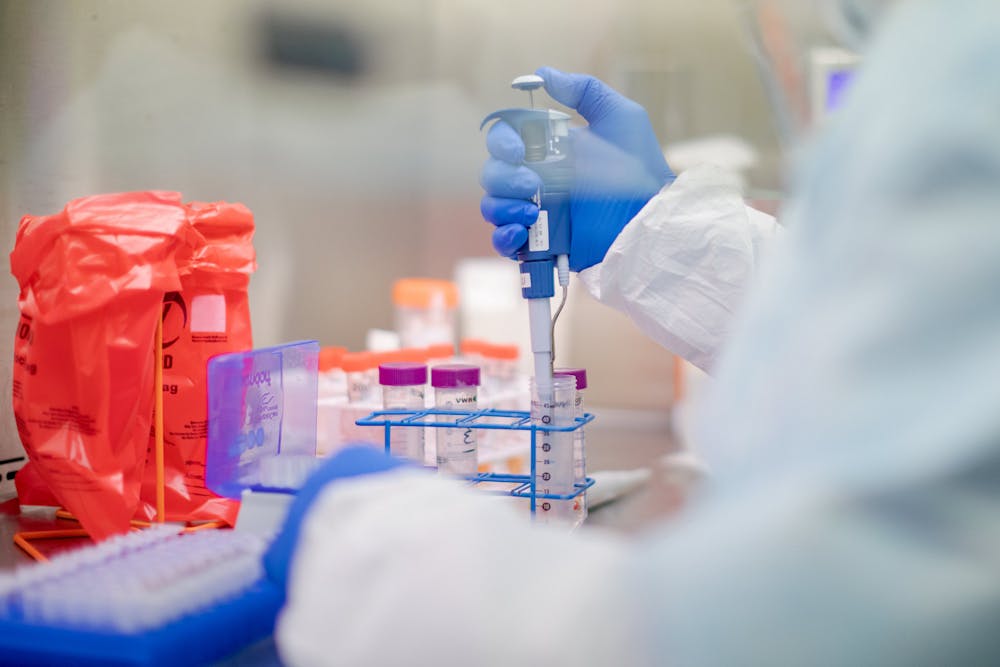During a conference call with Hopkins physicians and researchers early in the pandemic, the School of Medicine’s Vice Dean for Research Antony Rosen asked Brian Garibaldi if there was an association between a COVID-19 patient’s elevated D-dimer levels and their likelihood of being intubated.
By then, Garibaldi, who is the director of the Hopkins biocontainment unit and was part of the first team at the Hopkins Hospital to take care of COVID-19 patients, had seen over 40 COVID-19 cases. It was difficult to keep all the numbers in his head.
Rosen suggested that a dataset be created to allow physicians to easily extract clinical trends. Within about three months of their phone call, the team wrangled data from the electronic health record into an accessible format that researchers across the University could use. The result was the COVID-19 Precision Medicine Analytics Platform Registry (JH-CROWN).
The rapid development of JH-CROWN was possible largely because the infrastructure was already in place. The Precision Medicine Analytics Platform (PMAP) was created several years earlier to allow researchers to create comprehensive datasets to study multiple aspects of a disease, such as the clinical epidemiology and the pathobiology. Garibaldi and his colleagues partnered with the team who built PMAP to host JH-CROWN on the platform.
Over the course of hundreds of hours of meetings, the team chose the data elements that they wanted to pull from PMAP, verified that they extracted appropriate data and curated the dataset. Currently, there are 14 data elements in the registry, ranging from medication orders to social histories.
John Muschelli, an associate scientist at the School of Public Health, said that the effort showcased the strengths of PMAP in an interview with The News-Letter.
“It was probably one of the most successful cases of using the PMAP system. There are other ones that have gone through; this one was unique because time was of the essence,” he said. “This one was a rapid response and everyone was invested because we were all living through it.”
By October, according to Garibaldi, the COVID-19 and Data Research Evaluation (CADRE) Committee had approved 24 protocols that use data from the JH-CROWN registry and had reviewed over 130 different proposals from researchers who wanted to use the dataset. A study that Garibaldi led, published in January in the Annals of Internal Medicine, was among the first.
Garibaldi described the motivation behind this study.
“The first questions we wanted to answer was, ‘What happened in the first month of the pandemic? What could we learn from the data to help physicians on the front lines take better care of patients?’,” he said.
To answer those questions, Garibaldi and his colleagues created a model to determine if the information collected when a COVID-19 patient is admitted to a hospital (for example, vital signs, routine lab tests and comorbidities) is predictive of severe outcomes. Their study demonstrated that it was indeed — and to a reasonable degree of accuracy.
Jacob Fiskel, who completed his PhD at Hopkins, built the study’s predictive model using Lasso, a statistical analysis that employs machine learning. He elaborated on the process in an interview with The News-Letter.
“The method is extremely common these days,” he said. “The difficult part is making sure that your data is the right one to answer the question that you have.”
To give readers an intuitive feel of the analysis presented in the paper, the team created COVID-19 Inpatient Risk Calculator (CIRC).
Just as collaboration between physicians and statisticians was critical in the development of CIRC, it was also important in the creation of another prognostic tool, Severe COVID-19 Adaptive Risk Predictor (SCARP).
The predictions that are visualized in SCARP are the result of Random Forests for Survival, Longitudinal and Multivariate (RF-SLAM) data analysis. Shannon Wongvibulsin, an MD-PhD student at the School of Medicine who developed RF-SLAM, helped to create SCARP. Unlike CIRC, SCARP can predict a COVID-19 patient’s trajectory using the latest available information collected throughout a patient’s hospital stay.
One of the advantages of SCARP, Wongvibulsin noted in an email to The News-Letter, , is that physicians who use it can see the logic behind the result, making it more trustworthy.
“The results are conveyed along with a tree-based summary visualization to address clinician reluctance to blindly follow predictions from ‘black-box’ machine learning solutions when the underlying logic is uninterpretable,” Wongvibulsin wrote.
Once clinical models like CIRC and SCARP are developed, they need to be validated on larger datasets like the National COVID-19 Cohort Collaborative (N3C) Data Enclave, which is co-led by Dr. Christopher Chute, a professor at the School of Medicine. Additionally, the model’s effect on physician decision-making and subsequent effects on patient outcomes need to be tested. The team behind SCARP, Wongvibulsin said, are planning further studies to do both those things.
Garibaldi described the goal of the project.
“Our hope is that we can provide several tools that clinicians on the front lines can use as they are making triage decisions, but equally importantly, that we can use as we are talking to families, patients and loved ones,” he said.
The data in JH-CROWN have not only been used to develop prediction tools, but have also led to studies which tested the effects of remdesivir on clinical outcomes and characterized the risk of hospital-acquired infections, among others.
According to Garibaldi, datasets like JH-CROWN may represent a new path for personalized medicine, one where physicians are able to easily access detailed information about the multitude of factors that affect each person’s health — like their environment and their genetics — and use that information to precisely tailor their treatment.
“That is the future of medicine,” he said. “It will be trying to harness this information in a way that is useful for an individual patient in addition to having the population-level data that can inform public policy and broader health policy.”





